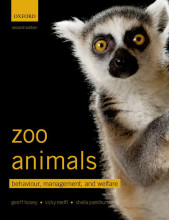Summary: Zoo Animals Behaviour, Management, And Welfare | 9780199693528 | Geoff Hosey, et al
- This + 400k other summaries
- A unique study and practice tool
- Never study anything twice again
- Get the grades you hope for
- 100% sure, 100% understanding
Read the summary and the most important questions on Zoo Animals Behaviour, Management, and Welfare | 9780199693528 | Geoff Hosey; Vicky Melfi; Sheila Pankhurst
-
1 Begrippenlijst
This is a preview. There are 14 more flashcards available for chapter 1
Show more cards here -
Annex A species
Species listed in the first of four annexes to the EU CITES legislation. They include all Appendix I species, as well as some Appendix II and III species for which the EU has adopted stricter measures than CITES -
2 Introduction
-
2.1 who is this book for?
This is a preview. There are 2 more flashcards available for chapter 2.1
Show more cards here -
Number of animal collections?
10.000 -
3 History and philosophy of zoos
This is a preview. There are 1 more flashcards available for chapter 3
Show more cards here -
What is a zoo?
A collection of exotic animals kept in captivity and show to the general public -
3.1 What is a zoo
-
Defintion of a zoo (Norton et al. 1995)
A proffessionally managed zoological institution accredited by the American Zoo and Aquarium Assiciation and having a collection of living animals used for conservation, scientific studies, public education and public display -
Defintion of a zoo (Baratay & Hardouin-Fugier 2002)
A place of forced meeting between animal and human -
Description of a zoo (AZA)
A permanent cultural institution which owns and maintains captive wild animals that represent more than a token collection and, under the direction of a proffesional staf, provides its collection with appropriate care and exhibts them in an aesthetic manner to public on a regulary schedueld basis.
They shall further be defined as having their primary business the exhibition, conservation and preservation of the earth's fauna in an educational and scientific manner. -
4 Behaviour
This is a preview. There are 7 more flashcards available for chapter 4
Show more cards here -
What implicate adaptive behaviour?
Behaviour has a genetic base, because it can change after multiple generations. So there is also a range in the type a behaviour that a animal can preform, so indivudaly differences.. -
What is adaptive behaviour?
Behaviour that can evolves over generations by the proccess of natural selection, changing animals so that they are better able to survive. -
What are examples of animal stimuli?
calls, chemical postures -
What are examples of physical stimuli?
light, temperature, sound
- Higher grades + faster learning
- Never study anything twice
- 100% sure, 100% understanding
































